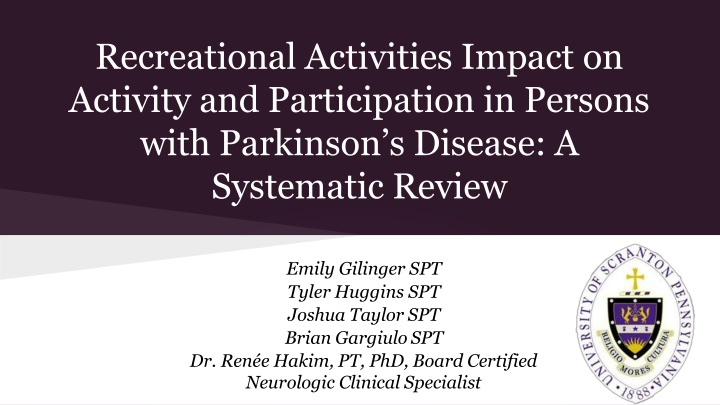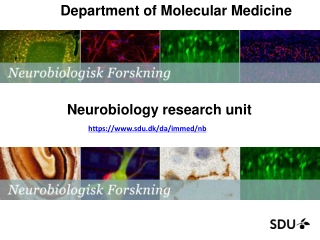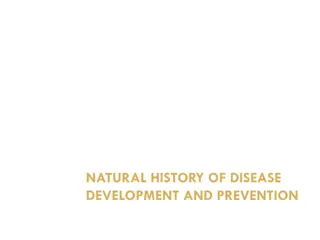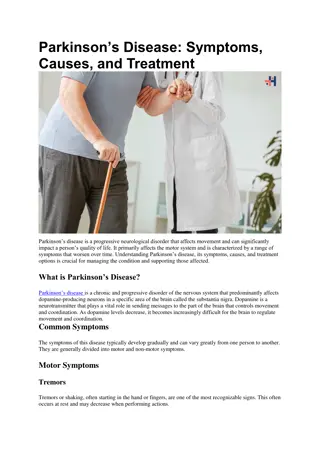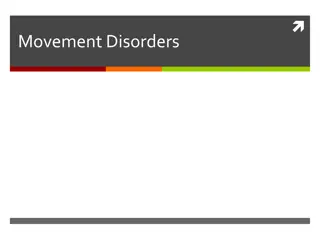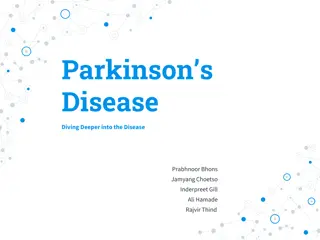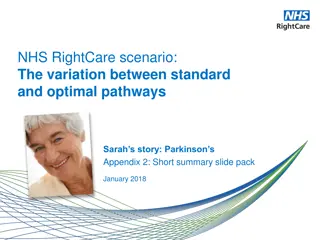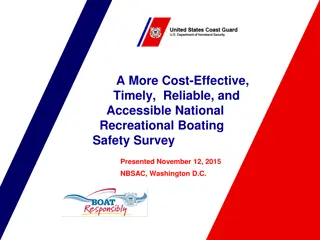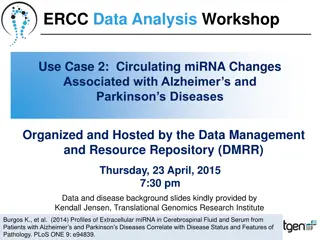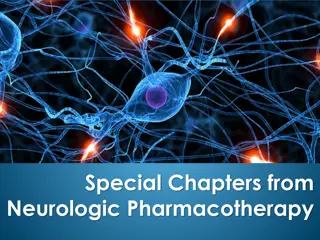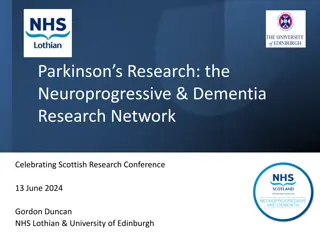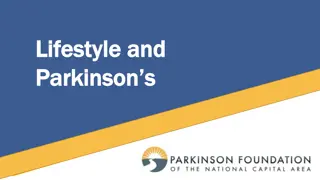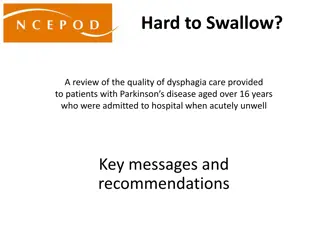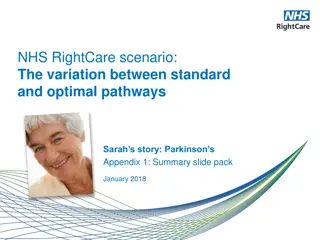Impact of Recreational Activities on Parkinson's Disease: A Systematic Review
This systematic review evaluates the effects of recreational interventions on activity and participation in individuals with Parkinson's Disease. The study highlights the importance of novel approaches in managing motor and non-motor symptoms of the disease through recreational activities. Various methods, search terms, and definitions related to recreational activities are explored to provide a comprehensive understanding of the topic.
Uploaded on Sep 07, 2024 | 4 Views
Download Presentation

Please find below an Image/Link to download the presentation.
The content on the website is provided AS IS for your information and personal use only. It may not be sold, licensed, or shared on other websites without obtaining consent from the author.If you encounter any issues during the download, it is possible that the publisher has removed the file from their server.
You are allowed to download the files provided on this website for personal or commercial use, subject to the condition that they are used lawfully. All files are the property of their respective owners.
The content on the website is provided AS IS for your information and personal use only. It may not be sold, licensed, or shared on other websites without obtaining consent from the author.
E N D
Presentation Transcript
Recreational Activities Impact on Activity and Participation in Persons with Parkinson s Disease: A Systematic Review Emily Gilinger SPT Tyler Huggins SPT Joshua Taylor SPT Brian GargiuloSPT Dr. Ren e Hakim, PT, PhD, Board Certified Neurologic Clinical Specialist
Overview Introduction Purpose Methods PRISMA PEDroScores Results Conclusion Limitations Future Research Clinical Relevance Acknowledgements 2
Introduction Progressive neurodegenerative disease affecting motor, sensory and cognitive function2 Impact one s independence and greatly increases risk of falls2 Second most common chronic neurodegenerative disease3 3
Introduction Typically pharmacologically managed3 Drug interactions and negative side effects are common occurrences3 Complementary or alternative approach allows patients to combat motor and non-motor symptoms3 4
Purpose The purpose of this systematic review was to evaluate the effects of novel, recreational interventions on activity and participation in persons with mild to moderate Parkinson s Disease (PD). 5
Methods Search Engines: ProQuest Nursing and Allied Health, Wiley, Science Direct, CINAHL, and PubMed/Medline Limits: Peer Reviewed, RCT, English language 6
Search Terms ( Parkinson'sdisease OR Parkinsondisease OR "PD" OR Parkinsons disease OR Parkinson s ) AND ( mind-body exercise OR fitness OR recreational activities OR hobbies OR exercise ) AND ( RCT OR Randomized Control Trial" OR "Randomised Control Trial") 7
Definitions Recreational activities - physical or mental activity pursued primarily for pleasure1 Hobby - an activity done regularly in one's leisure time for pleasure1 Leisure activities - an activity free from the demands of work or duty with a sense of unhurried ease1 8
Definitions Non-conventional - not part of a standard physical therapy protocol1 Mind-body exercises - form of exercise that combines body movement, mental focus, and controlled breathing to improve strength, balance, flexibility, and overall health1 9
Selection Criteria Selection criteria included: RCT design, participants with mild to moderate PD, and recreational activity as an intervention (defined by leisure activity or non-conventional PT treatment). 10
Outcome Measures Unified Parkinson Disease Rating Scale (UPDRS): Consists of the following five segments: 1. Mentation, Behavior, and Mood, 2. ADL, 3. Motor sections, 4. Modified Hoehn and Yahr Scale, and 5. Schwab and England ADL scale4 Minimal Clinical Important Difference (MCID) of -3.25 pts for meaningful improvement5 11
Outcome Measures Parkinson Disease Questionnaire (PDQ-39): Primarily used in clinical trials of therapeutics intended to benefit individuals with Parkinson s disease Self-report questionnaire Assesses Parkinson s disease-specific health related quality6 MCID of -4.72 pts for meaningful improvement7 12
PRISMA Identification Records identified through databasesearching (n = 1319) Records after duplicatesremoved (n = 927) Screening Records screenedby title andabstract (n = 927) Records excluded based on title or abstract (n = 853) Eligibility Records assessedfor eligibility (n =74) Records excluded, with reasons (n = 59) Conventional PT (n = 28) Incorrect outcome measures (n = 7) Study design (n = 20) Population (n = 1) Irrelevant (n = 2) Included Recordsincluded (n = 15) 13
PEDro Scores Author, Year 1 2 3 4 5 6 7 8 9 10 11 Total Combs et al 8 Y Y Y Y N N Y N Y Y Y 7/10 Duncan et al 9 Y Y N Y N N Y N N Y Y 5/10 Foster et al 10 Y Y N Y N Y N N Y Y N 5/10 Gao et al 11 Y Y N Y N N Y Y N Y Y 6/10 Hackney et al 12 Y Y N Y N N Y N N Y Y 5/10 Ni et al 13 Y Y N Y N N N Y Y Y Y 7/10 Lee et al 14 Y Y Y Y N Y Y Y Y Y Y 9/10 Li et al 15 Y Y N Y N N Y Y Y Y Y 7/10 14
PEDro Scores Author, Year 1 2 3 4 5 6 7 8 9 10 11 Total Kurt et al 16 Y Y Y Y Y N N Y Y Y Y 8/10 Rios Romenets et al 17 Y Y N Y N N N Y Y Y Y 6/10 Shanahan et al 18 Y Y Y Y N N Y N N Y Y 6/10 Sharma et al 19 Y Y N Y N N N N N Y N 3/10 Van Puymbroeck et al20 Y Y Y Y Y N N Y Y Y Y 8/10 Vergara-Diaz et al 21 Y Y N Y N N Y N N Y Y 5/10 Volpe et al 22 Y Y Y Y N N Y N N Y Y 6/10 15
Results Samples ranged from 10-90 subjects (580 total) Treatment parameters varied widely Durations ranged from 8 weeks to 2 years Frequency of application varied between 1-2 days per week and 60-90 minutes per session8-22 16
Results Four improvements in PDQ scores as follows: within group Boxing (-4.0 pts)8 and Yoga (-11.5 pts)13 between groups Tai Chi (-7.65 pts)21, Yoga (-16.7 pts)13, Irish set dancing (-8.4 pts)22 and Argentine Tango (-7.5 pts)17 out of 15 studies found statistically significant 17
Results Seven out of 15 studies found statistically significant improvements in UPDRS scores as follows: within groups Waltz, Argentine Tango, and Ballroom Tango (-8.05, -21.0, -7.2 pts)12, 9, 17, Turo Qi (-6.2 pts)16, Yoga (-10.9, -10.6 pts)13, 19 between groups Irish set dancing (-7.2 pts)22, Turo Qi (-6.2 pts)16 and Tai Chi (-6.4 pts)20 18
Results Subgroup meta-analyses showed improved overall mean differences (MD) for activity and/or participation as indicated by: UPDRS scores (n=12; MD=-6.704; 95% CI [9.48, -3.92]) PDQ scores (n=6; MD=-6.066; 95% CI [-10.41, -1.71]) 19
Conclusion There is moderate to strong evidence in support of using various recreational, leisure activities to improve activity and participation levels in persons with Parkinson s Disease. 22
Limitations Small sample sizes Self-report outcome measures Inadequate long-term patient follow-up Only 4 databases used in the search Studies varied by frequency and duration 23
Future Research Future studies should focus on: o Optimal training parameters o Providing operationalized descriptions of interventions o Additional evidence on boxing 24
Clinical Relevance Outcomes were more pronounced as they were significantly associated with continuing exercise outside of the study intervention. The most successful programs that exceeded Minimal Clinically Important Difference (MCID) values as follows: Tai chi and yoga, alone or combined with traditional therapy, for an average of 60 minutes, 2-3 times per week over 12-24 weeks. 25
Acknowledgements Dr. Ren e Hakim, PT, PhD, NCS Dr. Tracey Collins, PT, PhD, MBA, GCS Ian O Hara, MSLIS Physical Therapy Department at The University of Scranton 28
References 1. Caspersen CJ, Powell KE, Christenson GM. Physical activity, exercise, and physical fitness: definitions and distinctions for health-related research. Public Health Rep. 1985;100(2):126-131 Parkinson s Disease Foundation. Statistics on Parkinson s Disease. Accessed September 27, 2016. http://www.pdf.org/en/parkinson_statistics 2. Khallaf ME, Fayed EE. Kowal SL, Dall TM, Chakrabarti R, Storm MV, Jain A. The current and projected economic burden of Parkinson s disease in the United States. Mov Disord. 2013;28(3):311 8. Movement Disorder Society-Sponsored Unified Parkinson's Disease Rating Scale Revision. Shirley Ryan AbilityLab - Formerly RIC. https://www.sralab.org/rehabilitation-measures/movement-disorder-society-sponsored-unified-parkinsons-disease-rating-scale. Accessed October 2, 2019. Horvath K, Aschermann Z, cs P, et al. Minimal clinically important difference on the Motor Examination part of MDS-UPDRS. Parkinsonism Relat Disord. 2015;21(12):1421-1426. doi:10.1016/j.parkreldis.2015.10.006. Parkinson's Disease Questionnaire - 39. Shirley Ryan AbilityLab - Formerly RIC. https://www.sralab.org/rehabilitation-measures/parkinsons- disease-questionnaire-39. Accessed October 2, 2019. Horvath K, Aschermann Z, Kov cs M, et al. Minimal clinically important differences for the experiences of daily living parts of movement disorder society-sponsored unified Parkinsons disease rating scale. Mov Disord. 2017;32(5):789-793. doi:10.1002/mds.26960. Combs SA, Diehl MD, Chrzastowski C, et al. Community-based group exercise for persons with Parkinson disease: A randomized controlled trial. Neuro Rehab. 2013;32(1):117-124. doi:10.3233/NRE-130828 Duncan RP, Earhart GM. Are the effects of community-based dance on Parkinson disease severity, balance, and functional mobility reduced with time? A 2-year prospective pilot study. J Altern Complement Med. 2014 Oct;20(10):757-63. Doi: 10.1089/acm.2012.0774. 10. Foster ER, Golden L, Duncan RP, Earhart GM. Community-based Argentine tango dance program is associated with increased activity participation among individuals with Parkinson s disease. Arch Phys Med Rehab. 2013;94(2):240-249. doi:10.1016/j.apmr.2012.07.028 2. 3. 4. 5. 6. 7. 8. 9. 27
References 11. Gao Q, Leung A, Yang Y, et al. Effects of Tai Chi on balance and fall prevention in Parkinson s disease: a randomized controlled trial. Clin Rehab. 2014;28(8):748-753. doi:10.1177/0269215514521044. 12. Hackney ME, Earhart GM. Effects of dance on movement control in Parkinson s disease: a comparison of Argentine tango and American ballroom. J Rehab Med. 2009;41(6):475-481. doi:10.2340/16501977-0362 13. Ni M, Signorile JF, Mooney K, et al. Comparative effect of power training and high-speed yoga on motor function in older patients with Parkinson disease. Arch Phys Med Rehab. 2016;97(3):345-354.e15. doi:10.1016/j.apmr.2015.10.095 14. Lee H-J, Kim S-Y, Chae Y, et al. Turo (Qi Dance) Program for Parkinson s disease patients: randomized, assessor blind, waiting-list control, partial crossover study. Explore (NY). 2018;14(3):216-223. doi:10.1016/j.explore.2017.11.002 15. Li F, Harmer P, Liu Y, Eckstrom E, Fitzgerald K, Stock R, Chou LS. A randomized controlled trial of patient-reported outcomes with tai chi exercise in Parkinson's disease. J Clin Mov Disord. 2014 Apr;29(4):539-45. doi: 10.1002/mds.25787 16. Kurt EE, B y kturan B, B y kturan , Erdem HR, Tuncay F. Effects of Ai Chi on balance, quality of life, functional mobility, and motor impairment in patients with Parkinson s disease. Disabil Rehabil. 2017;40(7):791-797. doi:10.1080/09638288.2016.1276972 17. Rios Romenets S, Anang J, Fereshtehnejad S-M, Pelletier A, Postuma R. Tango for treatment of motor and non-motor manifestations in Parkinson s disease: A randomized control study. Complement Ther Med. 2015;23(2):175-184. doi:http://dx.doi.org/10.1016/j.ctim.2015.01.015 18. Shanahan J, Morris ME, Bhriain ON, Volpe D, Lynch T, Clifford AM. Dancing for Parkinson Disease: a randomized trial of Irish set dancing compared with usual care. Arch Phys Med Rehab. 2017;98(9):1744-1751. doi:10.1016/j.apmr.2017.02.017 19. Sharma N, Colgrove Y, , Robbins K, Wagner K. A randomized controlled pilot study of the therapeutic effects of yoga in people with Parkinson s disease. Int J Yoga. 2015;8(1):74. doi:10.4103/0973-6131.146070. 20. Van Puymbroeck M, Walter A, Hawkins BL, et al. Functional improvements in Parkinson s disease following a randomized trial of yoga. Evid Based Complement Alternat Med. 2018;2018:1-8. doi:10.1155/2018/8516351 21. Vergara-Diaz G, Osypiuk K, Hausdorff JM, et al. Tai Chi for reducing dual-task gait variability, a potential mediator of fall risk in Parkinson s disease: a pilot randomized controlled trial. Glob Adv Health Med. 2018;7:216495611877538. doi:10.1177/2164956118775385. 22. Volpe D, Signorini M, Marchetto A, Lynch T, Morris ME. A comparison of Irish set dancing and exercises for people with Parkinson s disease: a phase II feasibility study. BMC Geriatr. 2013;13(1). doi:10.1186/1471-2318-13-54. 28
Questions? 29
